FROGS AND TOADS
Frogs and toads are the most numerous of all the amphibians, with some 3,500 species worldwide. Pennsylvania is home to 18 native species of frogs and toads. Frogs and toads are usually easy to identify as a group, although there may be some difficulty in distinguishing between the species or even in separating frogs from toads. In Pennsylvania, neither has tails when fully grown and they are the only amphibians without tails.
EASTERN SPADEFOOT TOAD
Scaphiopus holbrookii
THREATENED SPECIES - SPECIES ACTION PLAN
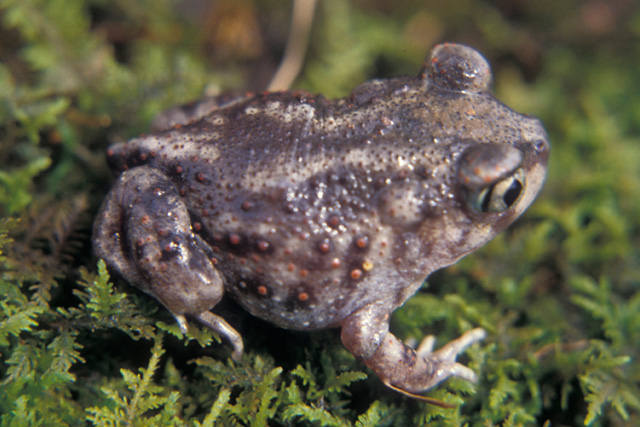 The eastern spadefoot toad is similar in appearance to the true toads. However, its skin is smooth and covered with minute tubercles, unlike true toads, which have rough, warty skin. It is the only spadefoot east of the Mississippi River. The adult size of the spadefoot is 1 3/4 to 2 1/4 inches, averaging a little less than the American and Fowler's toads.
The eastern spadefoot toad is similar in appearance to the true toads. However, its skin is smooth and covered with minute tubercles, unlike true toads, which have rough, warty skin. It is the only spadefoot east of the Mississippi River. The adult size of the spadefoot is 1 3/4 to 2 1/4 inches, averaging a little less than the American and Fowler's toads.
Populations are found in southcentral Pennsylvania in the Susquehanna River Valley from the Maryland border to the northcentral part of the state. The range becomes more narrow as it moves northward. The spadefoot also occurs along the extreme eastern edge of the state, beginning in the southeast corner where it follows the Delaware River Valley north to Monroe County. Its range extends into parts of New England and as far south as central Florida. Its western boundary is Missouri.
EASTERN AMERICAN TOAD
Anaxyrus americanus americanus
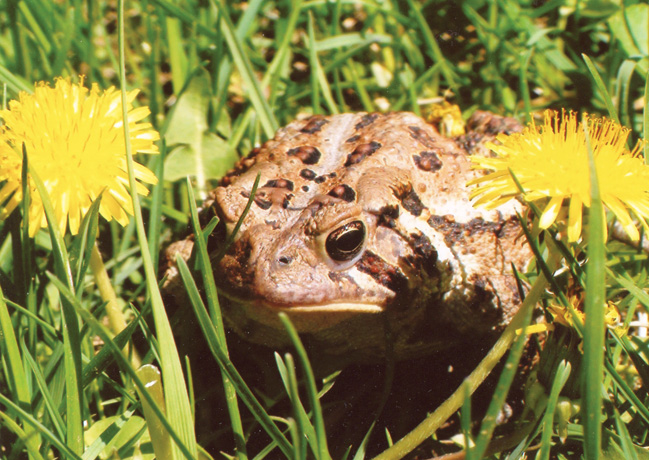 The eastern American toad, closely related to Fowler's toad, is more widely distributed in Pennsylvania. It can be confused with Fowler's toad, although there are several characteristics separating the two. Average adult size of the eastern American toad is two to 3 1/2 inches, about the same as Fowler's.
The eastern American toad, closely related to Fowler's toad, is more widely distributed in Pennsylvania. It can be confused with Fowler's toad, although there are several characteristics separating the two. Average adult size of the eastern American toad is two to 3 1/2 inches, about the same as Fowler's.
The eastern American toad, however, can tolerate colder temperatures and thus goes into hibernation a bit later than Fowler's and emerges a few weeks earlier in the spring. The eastern American toad is primarily nocturnal and spends most of its day sheltered among piles of leaves or burrowed under loose rocks. So even though it is an abundant toad throughout most of its range, its nighttime habits prevent it from being seen very often.
FOWLER'S TOAD
Anaxyrus fowleri
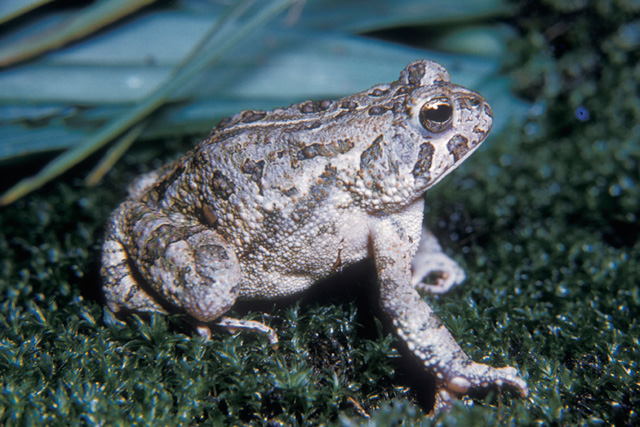 One of only two true toads in Pennsylvania, Fowler's toad is abundant throughout most of its range. It does most of its foraging at night, preferring to rest during the day when it burrows into the ground or hides among clumps of grasses. It is more slender and more agile than our other toad, the eastern American, but it cannot tolerate temperatures as low as the American toad can withstand. As an adult, Fowler's toad averages two to three inches in length, nearly identical to the eastern American toad.
One of only two true toads in Pennsylvania, Fowler's toad is abundant throughout most of its range. It does most of its foraging at night, preferring to rest during the day when it burrows into the ground or hides among clumps of grasses. It is more slender and more agile than our other toad, the eastern American, but it cannot tolerate temperatures as low as the American toad can withstand. As an adult, Fowler's toad averages two to three inches in length, nearly identical to the eastern American toad.
The skin of Fowler's toad is dry, a common trait among toads. Its general coloration is brown or gray with an occasional greenish specimen showing up in the population. A light, nearly white stripe runs down the middle of the back. Large dark spots or blotches, more or less arranged in pairs, cover the back. Each of the largest spots contains at least three warts. On the underside of this toad, the belly is white and unmarked, although a dark spot sometimes is found on the chest. Warts cover the thighs, but they are small compared to those found on the eastern American toad.
EASTERN CRICKET FROG
Acris crepitans
ENDANGERED SPECIES
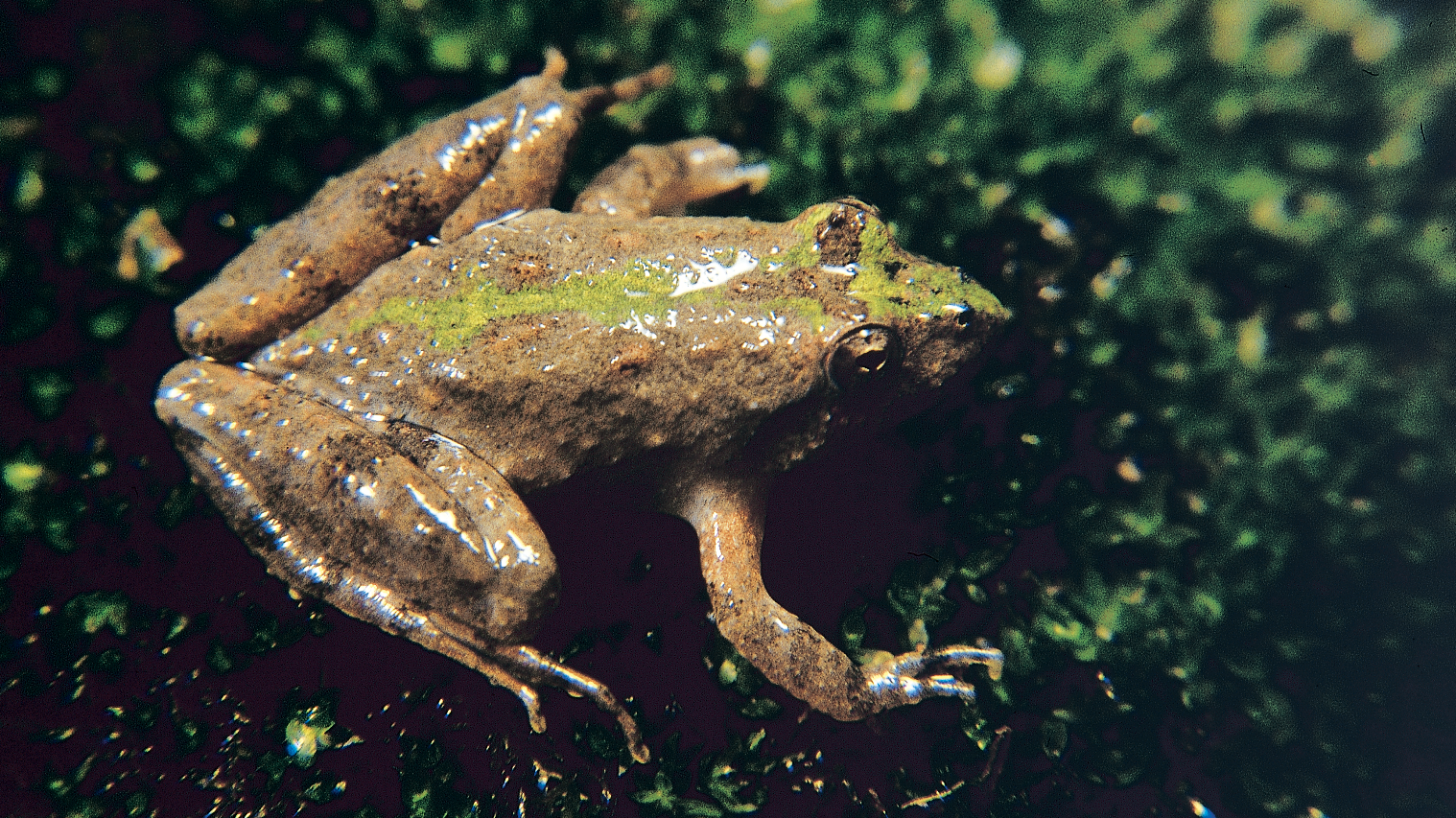 You may have to look twice to see the eastern cricket frog. Its coloration and small size allows this tiny amphibian to conceal itself easily, so it often is difficult to find even if nearby. As an adult, it averages only five-eighths to 1 3/8 inches long. It is diurnal and when not basking in the sun, spends the rest of its day foraging for food. Although a member of the treefrog family, the northern cricket frog is destined to spend most of its time on the ground because this species has lost the large, adhesive toe pads typical of the treefrogs.
You may have to look twice to see the eastern cricket frog. Its coloration and small size allows this tiny amphibian to conceal itself easily, so it often is difficult to find even if nearby. As an adult, it averages only five-eighths to 1 3/8 inches long. It is diurnal and when not basking in the sun, spends the rest of its day foraging for food. Although a member of the treefrog family, the northern cricket frog is destined to spend most of its time on the ground because this species has lost the large, adhesive toe pads typical of the treefrogs.
The eastern cricket frog occupies a little less than a quarter of the state. Found in the southeast corner, its range falls within an arc beginning in Franklin County, then curving north and east to the southern edge of the Pocono Mountains. It is distributed from Long Island south to the Florida panhandle, then west to just inside Texas.
COPE'S GRAY TREEFROG
Hyla chrysoscelis
GRAY TREEFROG
Hyla versicolor
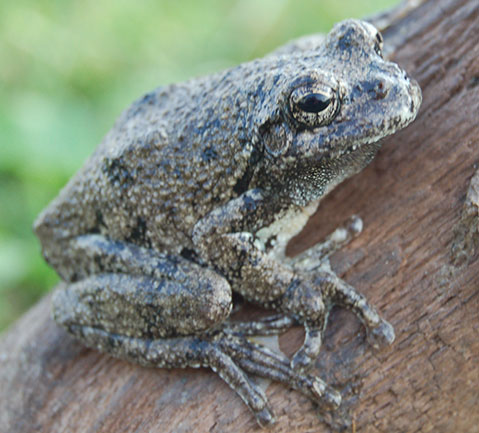 As treefrogs go, the gray treefrog is a moderately large animal, measuring 1 1/4 to two inches along its body. It is nocturnal and spends the day reposing beneath the loose bark or in the hollow of a tree. At other times it simply clings to the trunk or branch of a tree, where its color and pattern create a natural camouflage, blending in with the bark and concealing it from all but the keenest observer.
As treefrogs go, the gray treefrog is a moderately large animal, measuring 1 1/4 to two inches along its body. It is nocturnal and spends the day reposing beneath the loose bark or in the hollow of a tree. At other times it simply clings to the trunk or branch of a tree, where its color and pattern create a natural camouflage, blending in with the bark and concealing it from all but the keenest observer.
The gray treefrog is believed to be distributed statewide in Pennsylvania, missing perhaps from the Allegheny Mountains where documented sightings are sketchy at best. Except for northern Maine and southern Florida, this treefrog extends over the eastern one-third or better of the United States. Its western limit is generally marked with a line running from Manitoba in Canada to central Texas.
MOUNTAIN CHORUS FROG
Pseudacris brachyphona
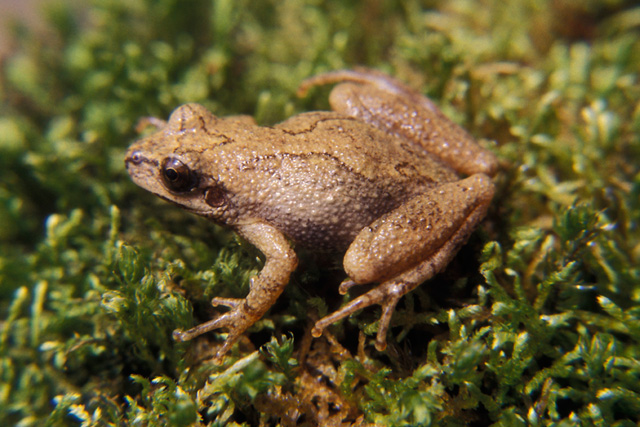 This member of the treefrog family is nocturnal. Though it is often heard, it is seldom seen, especially after the breeding season. In moving about, it leaps better than it walks. Adult sizes range from one to 1 1/4 inches in length.
This member of the treefrog family is nocturnal. Though it is often heard, it is seldom seen, especially after the breeding season. In moving about, it leaps better than it walks. Adult sizes range from one to 1 1/4 inches in length.
The small mountain chorus frog is light brown to green with some overtones of gray. The belly and undersides of the legs are yellowish. A key mark in identifying the mountain chorus frog is the pair of dark stripes on the back. These two stripes run lengthwise and curve inward and toward each other. The effect is two crescent-shaped marks that sometimes touch each other near their centers to form a crude "X."
Pennsylvania marks the northernmost extremity of the mountain chorus frog's range. It resides from here through southeast Ohio and into central Alabama. It ranges west of the Allegheny Mountains in counties in the southwestern corner of the state.
SPRING PEEPER
Pseudacris crucifer
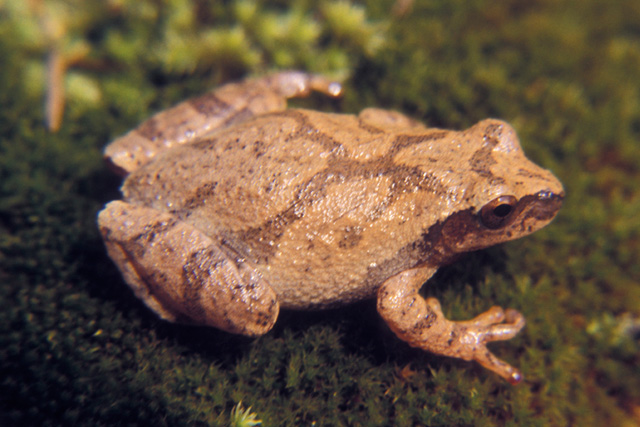 One of the state's tree-climbing frogs, the northern spring peeper belongs to the family Hylidae, as do all the tree dwellers. The northern spring peeper is seldom seen except during the breeding season, even though it is perhaps our most abundant treefrog. Nonetheless, its habitual and easily recognized call makes this small woodland amphibian one of our most familiar frogs. It averages in length from three-fourths to 1 1/4 inches as an adult.
One of the state's tree-climbing frogs, the northern spring peeper belongs to the family Hylidae, as do all the tree dwellers. The northern spring peeper is seldom seen except during the breeding season, even though it is perhaps our most abundant treefrog. Nonetheless, its habitual and easily recognized call makes this small woodland amphibian one of our most familiar frogs. It averages in length from three-fourths to 1 1/4 inches as an adult.
The most recognizable feature identifying the northern spring peeper is the large, dark, irregularly X-shaped mark in the middle of the back. A dark, modified Vee appears between the eyes, and the legs are barred with a dark color. The slender body is tan to light brown or grayish on the upper surface; the belly is light, becoming yellowish toward the rear but otherwise is unmarked.
UPLAND CHORUS FROG
Pseudacris feriarum
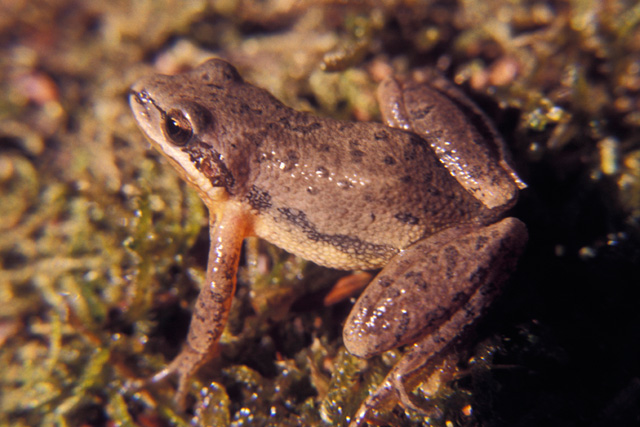 The upland chorus frog is usually greenish gray to light brown or tan. Darker stripes divide the back and might be broken into rows of spots on the upland chorus frog. The average adult reaches three-fourths to 1 1/2 inches in length.
The upland chorus frog is usually greenish gray to light brown or tan. Darker stripes divide the back and might be broken into rows of spots on the upland chorus frog. The average adult reaches three-fourths to 1 1/2 inches in length.
These small, secretive frogs can be found in a variety of habitats in grassy areas, either dry or wet, including swamps. They are rarely seen or heard except immediately after rains. Breeding occurs in shallow water from late winter to early summer. The upland chorus frog has been found in southcentral Pennsylvania to as far north as Lycoming County. The area in which it is sighted helps in identification and separates it from the western chorus frog which it resembles. The call is similar to the western chorus frog.
NEW JERSEY CHORUS FROG
Pseudacris kalmi
ENDANGERED SPECIES
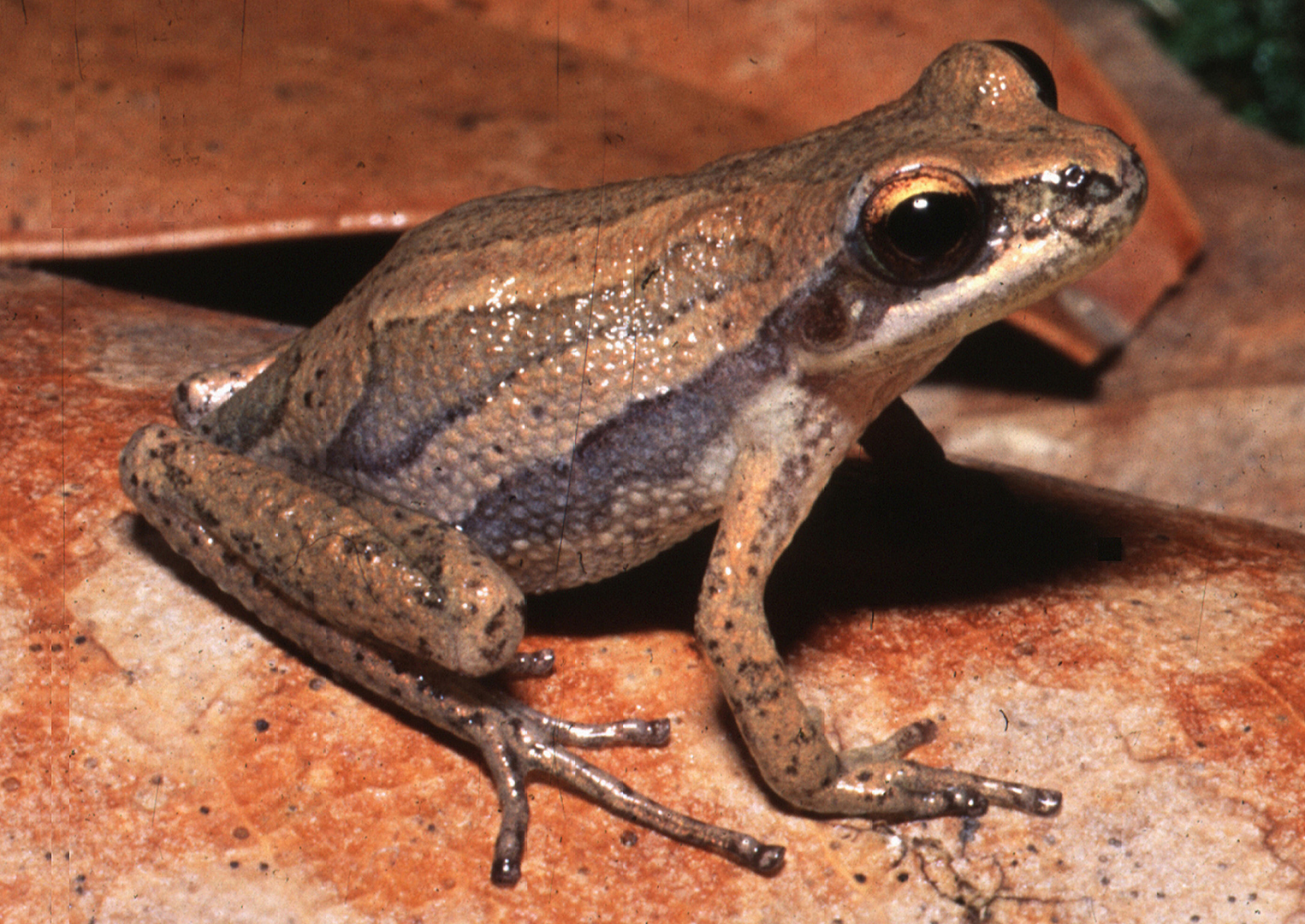 Like the upland chorus frog, the New Jersey chorus frog closely resembles the western chorus frog and is primarily differentiated by its range. In Pennsylvania, the New Jersey chorus frog has been reported only from the southeastern region of the state.
Like the upland chorus frog, the New Jersey chorus frog closely resembles the western chorus frog and is primarily differentiated by its range. In Pennsylvania, the New Jersey chorus frog has been reported only from the southeastern region of the state.
The adult New Jersey chorus frog averages three-fourths to 1 1/2 inches in length. Its color usually ranges from greenish gray to tan with dark stripes on both sides of its body. These stripes are more obvious on the New Jersey chorus frog than they are on the upland species. The upper lip is outlined with a narrow, white band.
WESTERN CHORUS FROG
Pseudacris triseriata
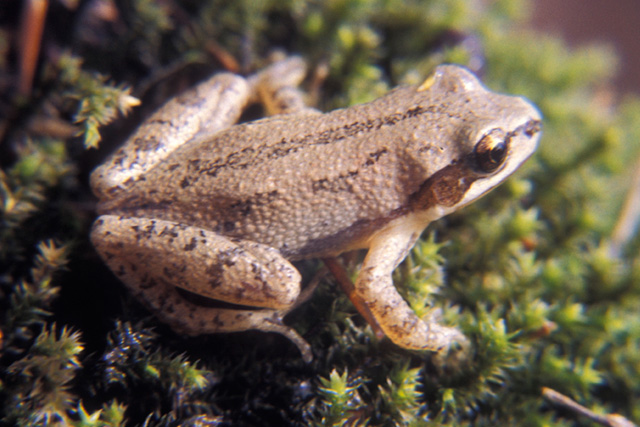 The western chorus frog averages three-fourths to 1 1/2 inches in length. This treefrog becomes most active late in the day as the sun sets. As a nocturnal creature, it usually is difficult to observe and becomes even more so past the breeding season when it spends most of its time in hiding.
The western chorus frog averages three-fourths to 1 1/2 inches in length. This treefrog becomes most active late in the day as the sun sets. As a nocturnal creature, it usually is difficult to observe and becomes even more so past the breeding season when it spends most of its time in hiding.
The smooth skin of the western chorus frog can be greenish gray to light brown or tan. The belly is off-white and usually plain, showing a lack of any markings. Three stripes, a gray or brown darker than the body color, divide the back. Another dark stripe begins on each side near the nostril, runs backward through the eye, along the side, and ends near the groin. A narrow, white band outlines the upper lip.
AMERICAN BULLFROG
Lithobates catesbeiana
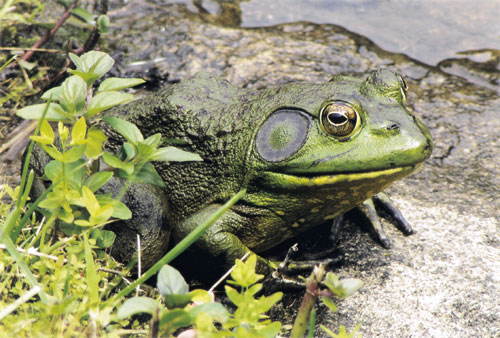 The bullfrog is a large aquatic frog. It, or at least its call, is familiar to anyone who has ever been near a large body of water during the evening or early morning hours in the summer. It is a solitary creature, more so than any of our other frogs, and does not engage in chorus singing even during the breeding season. In fact, the mating season may be the only time the bullfrog is prone to socialize at all, and then only with its mate. A bullfrog jealously guards its territory. Other males are aggressively kept from its calling site.
The bullfrog is a large aquatic frog. It, or at least its call, is familiar to anyone who has ever been near a large body of water during the evening or early morning hours in the summer. It is a solitary creature, more so than any of our other frogs, and does not engage in chorus singing even during the breeding season. In fact, the mating season may be the only time the bullfrog is prone to socialize at all, and then only with its mate. A bullfrog jealously guards its territory. Other males are aggressively kept from its calling site.
Adult sizes range from 3 1/2 to six inches. The bullfrog is a powerful swimmer with long, strong hind legs. The bullfrog uses these powerful appendages to push rapidly through the water. When swimming underwater, the bullfrog is able to lower its eyes to a level even with the head by pulling the eye sockets into the roof of the mouth. Thus protected, the eyes also are closed so that the frog can swim only short distances before having to stop, or at least slow down, to view the surroundings before moving on again at a rapid speed.
The legs of the bullfrog are considered a culinary delight by many people. In Pennsylvania, this amphibian is regulated by seasons and bag limits. Check the Summary of Fishing Regulations and Laws for details.
GREEN FROG
Lithobates clamitans
.jpg) This abundant frog is primarily nocturnal. It is most active at night but moves about and forages a bit during the day as well. Along with the bullfrog, it is more aquatic than many frogs. It is a medium-sized frog, slightly smaller, but otherwise similar in appearance to the bullfrog. Adult average sizes range from 2 1/4 to 3 1/2 inches. The northern green frog is more gregarious than the bullfrog, but it still maintains a more aloof attitude than some other frogs, living mostly a solitary lifestyle. It is not as wary as many other frogs, although when basking in the sun it sits alert, facing the water. This posture provides a quick escape into the water if danger threatens. A quick dive and it soon is lost among the bottom detritus, or gravel.
This abundant frog is primarily nocturnal. It is most active at night but moves about and forages a bit during the day as well. Along with the bullfrog, it is more aquatic than many frogs. It is a medium-sized frog, slightly smaller, but otherwise similar in appearance to the bullfrog. Adult average sizes range from 2 1/4 to 3 1/2 inches. The northern green frog is more gregarious than the bullfrog, but it still maintains a more aloof attitude than some other frogs, living mostly a solitary lifestyle. It is not as wary as many other frogs, although when basking in the sun it sits alert, facing the water. This posture provides a quick escape into the water if danger threatens. A quick dive and it soon is lost among the bottom detritus, or gravel.
In Pennsylvania, the green frog is protected by seasons and bag limits identical to those protecting the bullfrog.
ATLANTIC COAST LEOPARD FROG
Lithobates kauffeldi
ENDANGERED SPECIES
PICKEREL FROG
Lithobates palustris
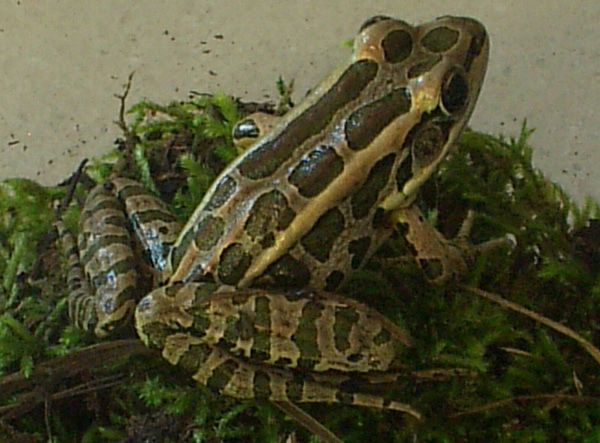 Going back to the earliest years of the 20th Century and before, this frog had been a popular bait used by anglers fishing for pickerel — hence its name. Today, although frogs still are used as bait, anglers should be aware that regulations affect the number of frogs they may have in possession at any one time. The pickerel frog is a medium-sized amphibian that averages from 1 3/4 to three inches as an adult.
Going back to the earliest years of the 20th Century and before, this frog had been a popular bait used by anglers fishing for pickerel — hence its name. Today, although frogs still are used as bait, anglers should be aware that regulations affect the number of frogs they may have in possession at any one time. The pickerel frog is a medium-sized amphibian that averages from 1 3/4 to three inches as an adult.
It benefits from a built-in defense mechanism particularly effective against snakes and other animals that normally prey on amphibians. And once experienced, snakes seem to avoid pickerel frogs — and even their lookalikes — thereafter. The pickerel frog secretes a substance from its skin that is at least irritating, but often toxic to would-be predators. It is distasteful and emits an extremely unpleasant odor that even humans find obnoxious. The secretion is toxic to frogs other than its own species and has been known to be fatal to other frogs when placed in the same water-filled container.
The pickerel frog is a spotted frog similar in appearance to the leopard frog, but with distinctly different markings. The pickerel frog has two rows of squarish spots down the back, but the leopard frog's spots are rounded and usually not in rows as well-defined as are those on the pickerel frog. Also, the leopard frog's wide head is more blunt than the pickerel's somewhat pointed snout.
NORTHERN LEOPARD FROG
Lithobates pipiens
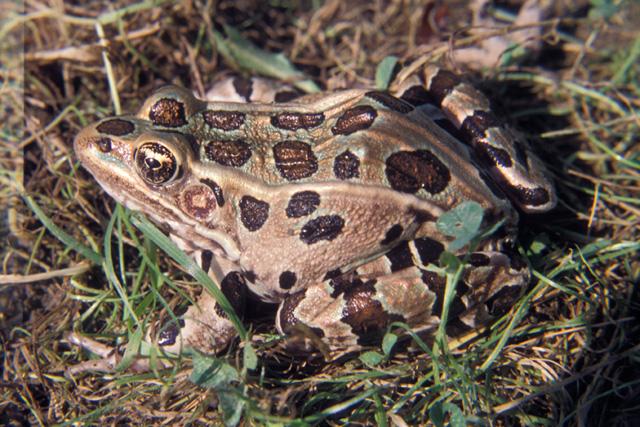 The leopard frog is one of our most attractive frogs. It is primarily nocturnal and prefers to spend the better part of the day in hiding. It comes out at twilight to fill the night air with its song or forage for a meal. Although extremely agile, those who have studied them say that the leopard frog is not as agile as its cousin, the pickerel frog. However, it does take honors for the longest jumper. Even the larger bullfrog cannot cover a greater distance in a single leap. If fleeing from danger, the leopard frog is able to cover a lot of ground, taking three or four long, low erratic leaps, each time going off in a different direction. Average adult leopard frogs attain lengths of two to 3 1/2 inches.
The leopard frog is one of our most attractive frogs. It is primarily nocturnal and prefers to spend the better part of the day in hiding. It comes out at twilight to fill the night air with its song or forage for a meal. Although extremely agile, those who have studied them say that the leopard frog is not as agile as its cousin, the pickerel frog. However, it does take honors for the longest jumper. Even the larger bullfrog cannot cover a greater distance in a single leap. If fleeing from danger, the leopard frog is able to cover a lot of ground, taking three or four long, low erratic leaps, each time going off in a different direction. Average adult leopard frogs attain lengths of two to 3 1/2 inches.
The leopard frog resembles the pickerel frog, although the body color is not tan as is usually the case with the pickerel frog. The leopard frog is brownish or green. Its dark spots are round, not the squarish shape of the pickerel frog's spots. The spots appear in two or three rows between prominent dorsolateral folds. The spots are black or reddish brown and edged with a lighter color that produces a halo effect around them. The wide dorsolateral ridges are creamy to yellowish or bronze. Dark spots also appear on the sides below the folds of skin.
COASTAL PLAINS LEOPARD FROG
Lithobates sphenocephalus utricularius
ENDANGERED SPECIES
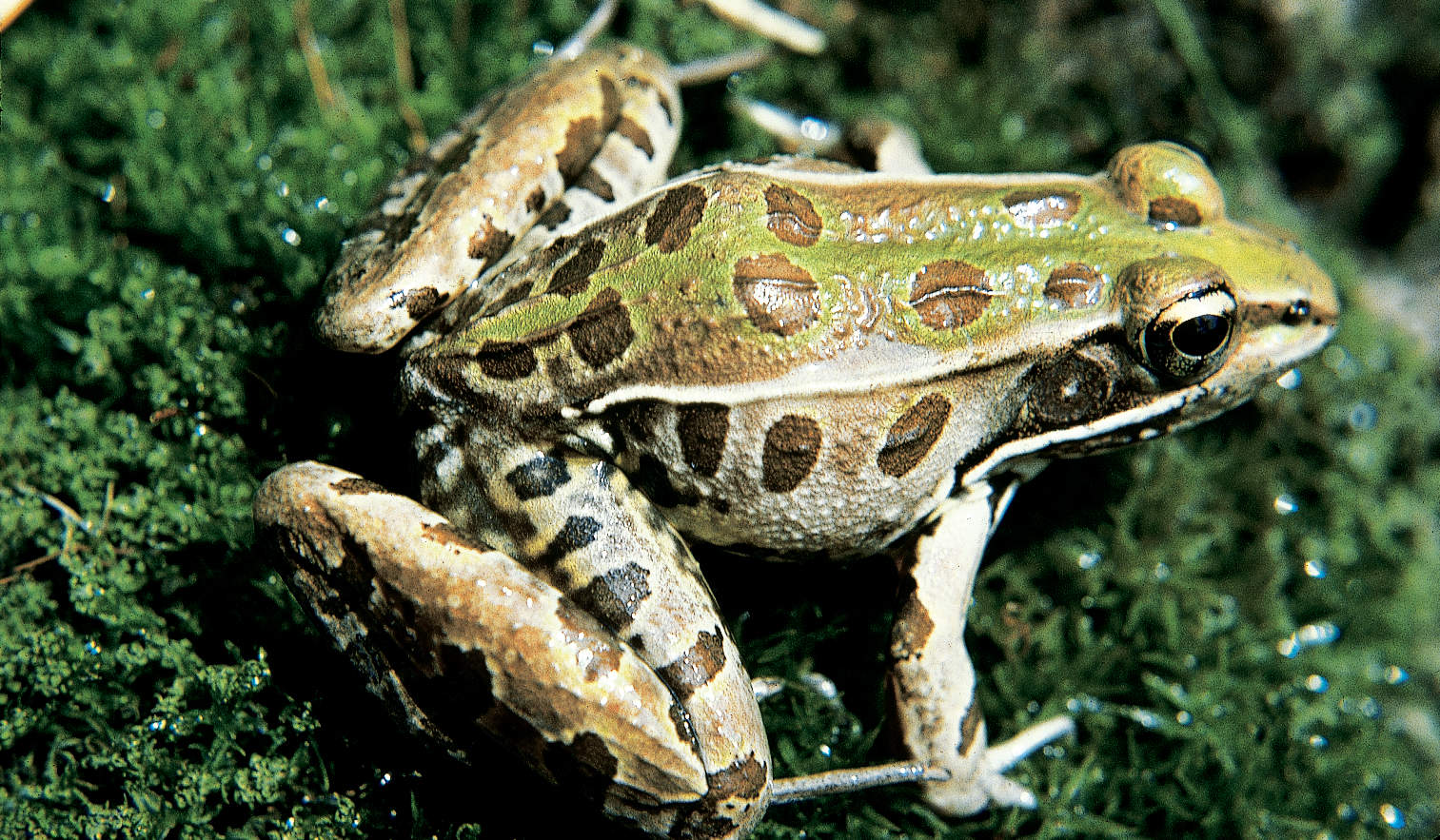 The Coastal Plains leopard frog resides in fresh or brackish water and in summer ventures into fields and meadows to wander among moist vegetation. It has been sparsely recorded in its original range in extreme southeastern Pennsylvania. It is primarily nocturnal.
The Coastal Plains leopard frog resides in fresh or brackish water and in summer ventures into fields and meadows to wander among moist vegetation. It has been sparsely recorded in its original range in extreme southeastern Pennsylvania. It is primarily nocturnal.
Reaching two inches to perhaps four inches in length, this frog looks similar to the northern leopard frog. The Coastal Plains leopard frog, however, has a whitish spot on the center of the eardrum, or tympanum, which the northern leopard frog does not have. Narrow dorsolateral ridges extend to the groin. The ridges are light-colored and are separated by dark spots. This leopard frog is greenish to brown over the back and sides. The legs are marked with dark spots or bars. The upper jaw is margined with a light line and the head is long and pointed. Breeding occurs from March to June when the female seeks shallow water in which she lays up to 5,000 eggs. The eggs hatch about two weeks later and transform by summer.
WOOD FROG
Lithobates sylvaticus
.jpg) The wood frog is most active during the day. Even so, due to its secretive and solitary nature and natural camouflage, it seldom is seen other than during the breeding season. This medium-sized frog's average adult length is 1 3/8 to 2 3/4 inches. More terrestrial than a lot of other frogs, the wood frog is also capable of jumping farther than most. In addition, when fleeing from danger it is able to turn itself around as it hits the ground to face a startled enemy eyeball to eyeball. Thus prepared, it can take other evasive measures, if necessary.
The wood frog is most active during the day. Even so, due to its secretive and solitary nature and natural camouflage, it seldom is seen other than during the breeding season. This medium-sized frog's average adult length is 1 3/8 to 2 3/4 inches. More terrestrial than a lot of other frogs, the wood frog is also capable of jumping farther than most. In addition, when fleeing from danger it is able to turn itself around as it hits the ground to face a startled enemy eyeball to eyeball. Thus prepared, it can take other evasive measures, if necessary.
The wood frog can find suitable habitat throughout the entire state. This frog is quite adaptable — it is found north of the Arctic Circle, the only North American frog residing in this frosty environment. It ranges across Canada to Alaska in the north and in its eastern range as far south as the southern Appalachians.
The Pennsylvania Amphibian and Reptile Survey (PARS) helps determine the distribution and status of all amphibians and reptiles, including frogs and toads, throughout Pennsylvania.